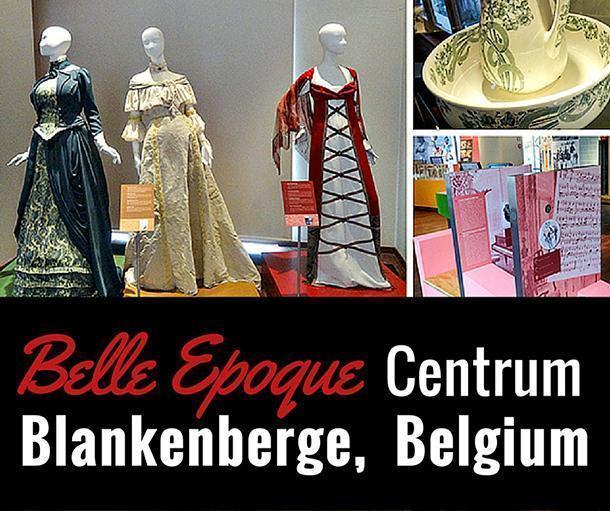
The coast always relaxes me. What better way to unwind than to escape from city life and experience the calming effect of the waves lapping the shore. We visited Blankenberge to make the best of the remaining days of 2015, in an exceptionally pleasant December. Blankenberge, with its proximity to Brussels and its appealing quayside, was a natural choice. The beach and city centre are within five minutes of each other, making visits to the centre and its attractions accessible and comfortable.
If you are like me and always look for a destination’s top attractions, chances are the Belle Epoque Centrum will figure at the top of any list for Blankenberge. The ‘Belle Epoque,’ or beautiful era, refers to the period between 1870 and 1914, just before the beginning of the First World War. The year 1870 marked the beginning of the second industrial revolution and turned Blankenberge from a sleepy fishing village to a resort town where the affluent flocked to experience the good life. This led to the creation of stately homes, coastal villas, and opulent hotels in the town.
Belle Epoque Centrum houses relics from the era and takes you back in time in a very enthralling manner.
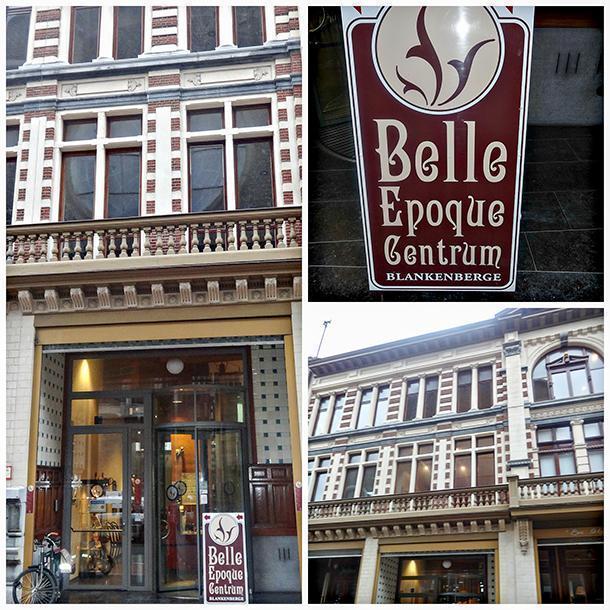
The Belle Epoque Centre with its Art Nouveau facade
The Belle Epoque centre is a museum or an exhibition centre that was renovated and opened to visitors in 2008. The centre was carved out of three stately homes from the Belle Epoque period and is spread over three floors. As suggested in the visitor’s guide, we began our visit on the terrace. The terrace has a beautiful mosaic, semi-circular seating arrangement, reminiscent of Gaudi, made from tiles from one of the villas of the epoch. The ceramic floor, the stained glass window, and the frosted glass door with the church in the background and the open skies, made for a surreal experience.
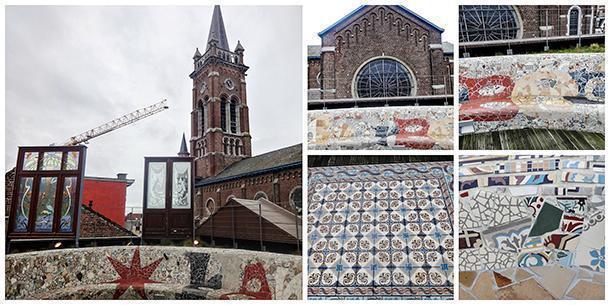
The magnificent terrace with its Gaudi-esque seating and ornamental floor tiles
The museum’s second floor gives a good sense of what the residence was like in the ‘Belle Époque’ era. It showcases examples of woman’s evening attire on mannequins. (Notice the elegant drapery, overskirts and the square neckline.) Photos, reminiscent of the past, are displayed and some of them have a viewing hatch, providing a present day view of the building.
A music module has been created so visitors can listen to small pieces from the period. Similarly, one can experience life at the beach and see the various ceramic bathing utensils on display.

The second floor with mannequins attired in Belle Epoque fashions, bathing utensils, music module, and photo with a viewing hatch (see lower right)
One of the most interesting aspects of the museum is the numerous interactive platforms, on every floor. You can choose a postcard depicting the life of the period, and instantly send it to your loved ones by mail, or see the different types of activities that defined the period, just by the touch of a button.
One interesting display tests your sense of smell, with each picture corresponding to a particular scent. You press a button, experience the scent, and then try to relate it to the picture. The interactive platforms are great to hold interest and also serve as an educational tool for children or Gen-Z teenagers.
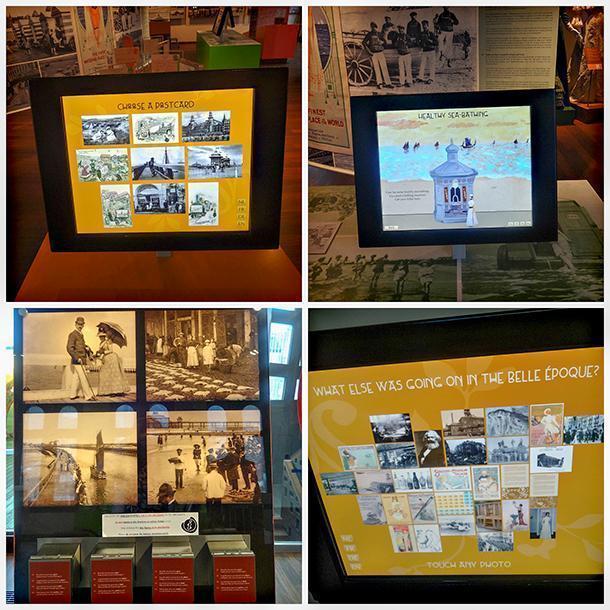
Various interactive modules in the visitor centre
The first floor is unique, as it retains the original flooring of the villas from the epoch, but has been renovated just enough to meet the aesthetic eye. It is spread over four rooms. One of the rooms has a ceiling made from a stained-glass window procured from a local pastry shop. It showcases the wonderful Art Nouveau style so very characteristic of the Belle Epoque period.
Interestingly, it also has a poster depicting the names of all the brilliant scientists, naturalist authors, poets, and musicians who drove the scientific and cultural innovations during the period. The first floor also contains a room that shows the planning required to turn Blankenberge into a touristy seaside town.
Continuing with the interactive nature of the museum, this floor has jigsaw puzzles, and Lego art, by Dirk Denoyelle, a Lego certified artist. The museum uses multimedia intelligently to present the antiquities in an engaging manner, keeping in mind the evolving tastes of the audience. There is also a film that showcases images from the seaside during this beautiful period.

Fist floor with its stained-glass ceiling and the original floor
We then visited the Bel-Etage, the beautiful floor, which exhibits a living room and a terrace of an 1894 villa. The room has been refurbished and exhibits furniture pieces, crockery, wall pieces, and other curios reflecting the Art Nouveau style. Mannequins with clothes belonging to the working-class population are also included. The most exquisite feature of the room is the wallpaper, which is authentic and has been restored by the famous wallpaper company, Zuber, from Rixheim France.

Bel-Etage with its original wallpaper
The basement is also imposing, with its collection of different exhibits from the era. Since Blankenberge is known for its exquisite wall tiles, we were happy to see tiles reflecting both the Art Nouveau and Art Deco styles. It also has a wonderful exhibition of photographs that give us an idea about the restoration of the stately homes in the now impressive Belle Epoque Visitor Centre. If you want to know more about the captivating history of the place, a screen provides a ‘heritage walk’ of the area. The director informed us there is always a temporary exhibition in the basement as well as a permanent one.
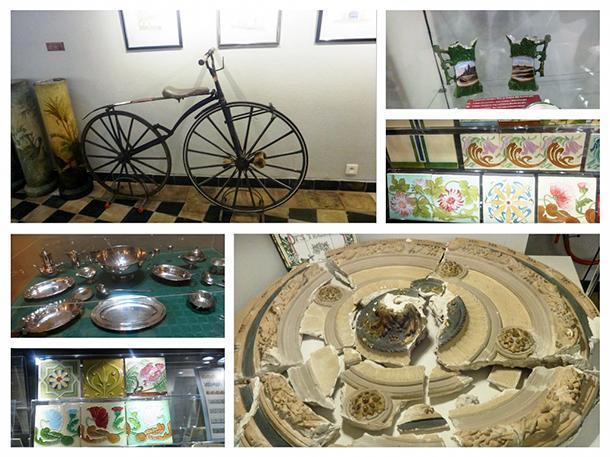
The basement with its exhibits (notice the Art Nouveau and the Art Deco tiles)
The Belle Epoque Centre is open to individuals in the afternoon, throughout the year. If you are in a group or need an educational tour for children, you can make a booking in advance for a morning tour, with a guide who speaks your language. All the photographs in the centre have captions in English, French, and Dutch. The centre is a five-minute walk from the nearest tram station and is accessible on all floors by an elevator. I took the stairs because they are just so beautifully designed by the Belgian architect, Luc Deleu. The windows are immense and inspire delight as you watch them while navigating your way down the stairs.
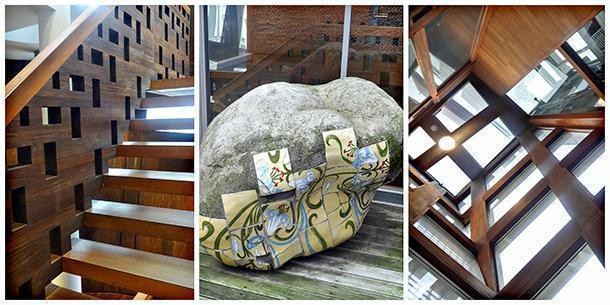
Awe-inspiring windows and stairs
The Belle Epoque Centre is a true reflection of the Belle Epoque era, with its first-rate collection of artefacts. It not only celebrates the optimism and luxury of the epoch but also offers a glimpse of the life of the local working-class fishermen, in Blankenberge
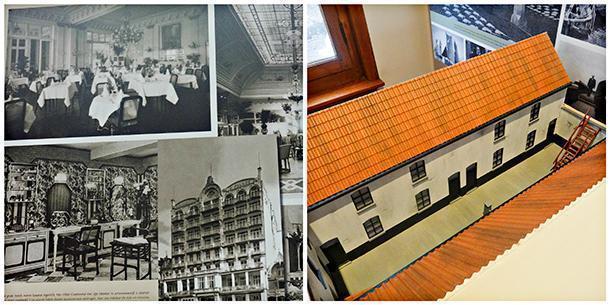
Photos of the luxurious hotels and residences of the rich, in sharp contrast to a poor fisherman’s courtyard.
It helps us to understand the disparity between the working class and the wealthy of that period and the lives they led. It also makes us appreciate the innovations that took place in the period, making our lives easier and more comfortable. Importantly, the collection of the relics is delightful and one can easily appreciate the hard work behind the renovation and the passion with which the visitor centre is run by its very efficient director, Dirk Decoster.
The Belle Epoque Centrum is definitely a must see if you are in Belgium. If you are planning a visit in the coming year and happen to be a fashion aficionado, there is good news for you. The director informed us the focus of the thematic exhibition in 2016 will be on fashion in the Belle Epoque and it will run from May to November.

Like this article? Save it to Pinterest!
Belle Epoque Centrum Blankenberge
Elisabethstraat 24
8370 Blankenberge
- Visiting the Prehistomuseum in Liege, Belgium - October 15, 2019
- Where to Find the Best Indian food in Belgium - July 17, 2019
- Review: Terhills Hotel, Maasmechelen, Belgium - July 4, 2019
